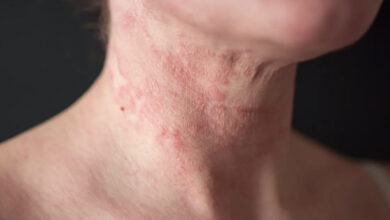ROSACEA: W.C. Fields’ Disease

W.C. Fields is a name younger people probably don’t recognize but when prompted will remember him as the movie actor from the 1930’s with the big nose. In fact, other than his recognizable voice inflection, his red, bulbous nose is the most memorable thing about him. He was a comedic actor who was troubled by a chronic skin disease called Rosacea which resulted in his big nose (rhinophyma). Rosacea, previously called Acne Rosacea, was thought to be a form of adult acne. It is similar to acne vulgaris, but rosacea is a disease of adults, not adolescents or teens. Both disorders have pustules and redness, but blackheads are absent in Rosacea.
Major differences are as follow:
ROSACEA: ACNE VULGARIS:
Adult disease Adolescents and teens
Blackheads absent Blackheads common
Limited to face(nose,cheeks,chin,forehead) Pustules, cysts face, chest, back, neck
Persistent redness of involved skin Redness localized to pustules
Telangiectasias(dilated small blood vessels) No telangiectasias
Rhinophyma(bulbous nose)* Prominent scar formation from cyst lesions
Both rosacea and acne vulgaris are cosmetically embarrassing disorders. Flushing and blushing are common early symptoms of rosacea. Skin involvement is limited to the central facial areas—nose, cheeks, forehead, chin. Besides redness and inflammatory nodules, the skin has characteristic broken, dilated blood vessels (telangiectasias) in affected areas. Telangiectasias are a classic diagnostic criterion.
* Nasal involvement results in inflammation of the oil (sebaceous) glands of the nose. Inflammation causes the oil glands to swell and increase in number causing a large, red bulbous nose called rhinophyma. Commonly, alcohol abuse was thought to be synonymous with the rhinophyma of rosacea, but it is well-established that alcohol is the not the cause. The social stigma remains, however.
Although the specific cause of rosacea is unknown, there are numerous triggers or stimuli that affect it. These are:
- Sunlight— ultraviolet light rays
- Stress, Anxiety — cause flushing, blushing, perspiration
- Hot weather, baths, saunas
- Alcohol — especially red, and some white, wines
- Spicy foods, seasonings
- Skin care products — alcohol, witch hazel, menthol, perfumes
- Wind and cold weather
- Exercise — sweating, flushing
- Drugs — topical steroids, vasodilators, thiazide diuretics, nitrates, BP drugs
- Other — dairy products (milk, yogurt, cheese)
The initial treatment of rosacea would obviously include avoidance of these triggers. For example, offending medications should be switched to non-irritating drugs and alcohol intake limited. This is a good start, but rosacea is not curable and requires constant attention.
Treatments for rosacea are numerous. Topical and oral drugs, washes, and cosmetic procedures are recommended.
Oral Antibiotics: tetracycline, doxycycline, minocycline taken long term
Topical Antibiotics: erythromycin, clindamycin, metronidazole (Metrogel), Klaron
Skin/facial cleansers: sulfa-based face washes, Clearasil, Rosamil
Topical Vitamin A: Retin A, Tazorac, Differin,
Other topicals: Azalex (antiseptic), Soolantra & Elimite (anti-parasitic)
New topicals: Mirvaso, Rhofade (reduce redness)
Other: Accutane has been used (4-6 mos)
Cosmetic procedures: Laser, Pulsed light, Photodynamic therapy, Glycolic peel
ROSACEA is a common skin condition (3 million cases/yr) of adults easily diagnosed by its classic clinical appearance. It is chronic and incurable, but is manageable with the numerous treatments available. The major complication, rhinophyma (WC Fields bulbous nose), gives others the incorrect impression the patient is a heavy drinker. But it is true rosacea can reduce a person’s quality of life. Studies show patients with rosacea experience feelings of frustration and embarrassment, have low self-esteem, suffer anxiety and depression, and have problems interacting at work. It would be difficult to live with others always thinking you’re a drinker and staring at the obvious rash on your face. So effective treatment is important.
Dr. G’s Opinion: The negative stigma associated with Rosacea is unfair and unfounded. Alcohol can aggravate it, but it doesn’t cause it. The rash can be unsightly when it flares or is untreated, but with so many oral and topical treatment options available, patients shouldn’t have to deal with social rejection. Effective treatment does depend on the patient’s commitment and adherence to the treatment regimen.
References:
aad.org/public/diseases/rosacea/causes
aad.org/public/diseases/rosacea/treatment



